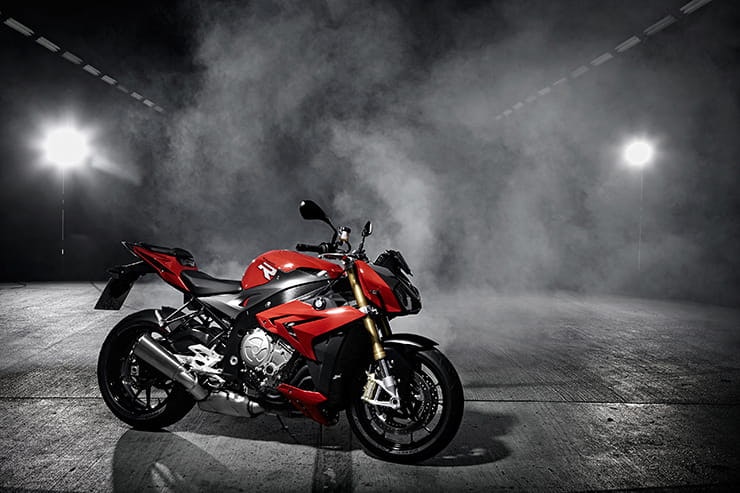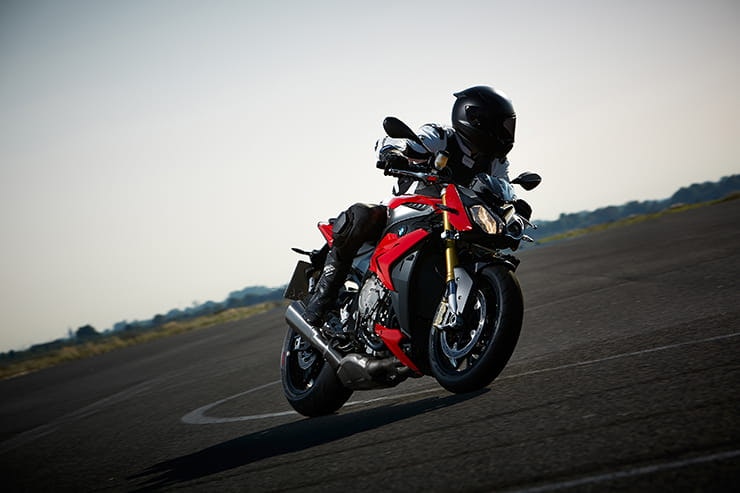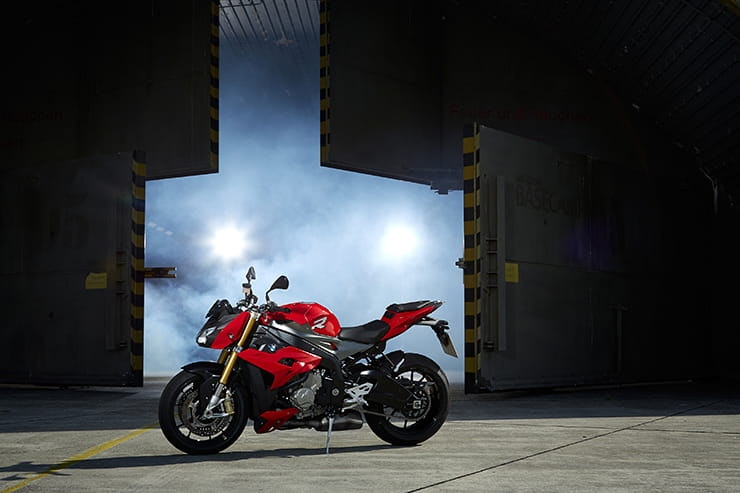BMW S1000R (2014-2020): Review & Buying Guide
By Jon Urry
Massively experienced road tester
07.03.2023
Price: £6000-£11,500 | Power: 160bhp | Weight: 207kg | Overall BikeSocial Rating: 4/5
In 2014 BMW unleased the bike that many were holding their breath for – a naked version of their all-conquering S1000RR sportsbike. Oh yes, a naked RR – what more could you want? Boasting a claimed 160bhp and using (virtually) the same chassis and motor as the RR, the R may have lost a few bhp in its transformation from RR to R but that didn’t really matter. Unlike so many rival naked bikes, BMW hadn’t compromised when it came to the R’s electronics package and with the option of angle-responsive TC and ABS, semi-active suspension and more (including heated grips...), the R certainly had enough tech to please. But, and this is the crucial part, despite its more than ample power delivery, the R was never a totally wild and uncontrollable beast of a naked bike, meaning it appealed to a wide range of riders. Not as expensive as you might imagine in the used market, if you are after a very rapid roadster that has lots of tech, the S1000R is a great option. It’s not as bonkers to ride as the likes of a Tuono V4 or Ducati Streetfighter but in many ways that actually counts in its favour and makes it a far more appealing road bike as a result.
BMW S1000R (2014-2020) Price
The S1000R was sold in two main variants and in 2014 the stock model cost £9990 where the Sport version, which basically added IMU-controlled electronics (TC and ABS), semi-active suspension, extra power modes and a quickshifter to the party, was £11,390. The vast majority of R’s sold were Sport models but a few buyers opted to down-spec, which does harm used values quite considerably as a lot of eye-catching parts such as the semi-active suspension or IMU can’t be retro-fitted. A stock 2014 S1000R with just under 20,000 miles on its clocks will cost you roughly £6000 where a Sport will be closer, or just over, £7000. Prices range from £6000 to £9000 for 2014-2016 models with prices for the slightly updated 2017 model starting at £8000 and rising to £11,500 for a high-spec Sport model with a low mileage. As with all BMW models, price is very much determined by mileage and the number of official extra that have been ticked and most bikes under five years old are sold through official BMW dealerships.
Strong engine
Good array of electronics
Surprisingly practical
It’s no head-turner
Vibrations can be annoying
If you want a barking super naked, it’s not for you
Engine and Performance
Billed by BMW as a ‘high performance roadster’ the R certainly doesn’t disappoint when it comes to the headline power and torque figures. Yes, the inline four engine has had 2000rpm chopped off its red-line and where the RR makes a claimed 190bhp the R produces 160bhp, but dig a bit deeper and you discover that the R makes a claimed 10Nm more torque than the RR up until 7500rpm thanks to new cams, which is bang on the range you want it to be on a naked bike. And that’s exactly how it feels to ride.
A remarkably strong and gutsy motor with a peak torque figure of 112Nm, the R’s engine drives cleanly and smoothly from very low in its rev range and feels perfectly at home in a naked bike format. Although far from a slouch, it doesn’t demand to be ridden hard and in that sense is very much a roadster rather than a pure super naked in its attitude. That said, get it spinning and it is blisteringly fast, but once you get over 70mph its lack of fairing means you are hanging on pretty firmly and it’s not much fun in such a strong windblast. But it's not perfect and the original model did develop a bit of an unwanted reputation for vibrations, something that BMW attempted to cure in the 2017 update through vibration-damping added to the handlebars. This second generation also gained a claimed 5bhp increase in power, not that you would really notice it, and a louder exhaust.
When buying used, the R’s engine is pretty under-stressed so all should be well mechanically. Unlike the RR it doesn’t have a habit of eating gearboxes (possibly down to less track use) and aside from ensuring the radiator isn’t damaged or corroded, all should be well. Most BMW bikes tend to have a good service history but be aware that at 18,000 miles the R requires a valve clearance check, which is about £600 to get done – assuming nothing need altering! If it does, that will add about £100-200 to the bill. Although the stock exhaust does discolour quite badly, it doesn’t rot, although this doesn’t stop owners replacing it. Don’t worry if the bike has an aftermarket exhaust fitted (as long as it isn’t too noisy...) as the bike’s fuel system will self-diagnose via the lambda sensor and correct itself to suit, meaning a dyno run and fuelling tweak isn’t totally necessary. Owners generally reckon Rs run better on super unleaded fuel tan the cheap stuff but this choice is often wallet-dependent! When buying used, always check the consumable items as a set of chain and sprockets for the R is surprisingly expensive – if you buy official BMW items...
BMW S1000R (2014-2020) Handling & Suspension
The R’s chassis is heavily based around the RR’s and that means it most certainly handles. Although not as quick turning as the likes of the Tuono V4, the R is nonetheless sporty when requested but also nice and relaxed when asked to be – traits that make it feel more a sporty roadster than a super naked and are due to more relaxed geometry when compared to the RR and a 22mm longer wheelbase.
As standard the R’s suspension lacks preload adjustment on the front but can have its rebound and compression tweaked and the rear can have its compression and preloaded altered however this set-up changes with the addition of Dynamic Damping Control (DDC), which is BMW’s semi-active suspension system. The vast majority of bikes have DDC fitted, which certainly enhances the overall ride quality (and adds preload adjustment to the forks) but as with all such systems, does require checking all is functioning when buying used as a new shock will set you back in the region of £1000 (a few companies will rebuild it for you but BMW state it isn’t rebuildable). Generally they seem to last about 20,000 miles before requiring changing or refreshing, but this is a very rough guide.
With DDC fitted the ride quality on the R is extremely good and switching between modes (Rain, Road, Dynamic, Dynamic Pro) certainly gives a noticeable change in the damping rates. As you would expect on a BMW model, the ABS (which is angle-responsive if you tick this option or buy a Sport) is excellent and the bite from the Brembo brakes more than enough for rapid road riding. Technically the brake fluid should be changed every two years, which is worth doing as getting any contamination into the ABS unit can result in a big bill! Check the fluid is nice and clear as that hints it has been changed regularly.
Comfort & Economy
The R is a naked bike so comfort isn’t really at the top of its priority list. As long as you keep the speeds down the R’s actual seating position is very spacious and relaxed but it is the windblast due to its lack of fairing the is a literal pain in the neck. A fair few owners fit small screens, which look ugly but do deflect a bit of the wind. Early bikes come in for criticism over vibrations, which BMW attempted to sort out in the 2017 update through damping in the bars but if your bike is an older model, try heavier bar end weights if vibes bother you.
When it comes to economy, owners report averaging about 38mg, which is decent enough on a naked bike and gives a tank range of approximately 180 miles.
BMW S1000R (2014-2020) Equipment
It’s a BMW so there is a long list of accessories and optional extras, most of which add to a bike’s used value if fitted. BMW sold two ‘packs’ for the S1000R – Sports and dynamic. Sports consisted of Dynamic Traction Control (DTC), Riding Modes Pro (which added Dynamic and Dynamic Pro modes), gear shift assistant and cruise control. Dynamic added Dynamic Damping Control (DDC), heated grips (how are these dynamic???), LED indicators and a small engine spoiler. All of these could be added to the bike separately but in general, most owners went for the Sport model which came with most of the two packs added. Aside from these options, BMW sold a range of HP bolt-on accessories such as carbon mudguards etc as well as a tank bag, comfort seats, screen and pillion seat cover. Those with deep pockets could also opt for the HP full titanium exhaust or the (more common) Akrapovic sports silencer. All of BMW’s official accessories or add-on parts tend to add value to a used bike – especially the lightweight forged Motorsport HP wheels, which were over £1000 new!
Most used bikes tend to be fairly standard but a few come with aftermarket tail tidies, screens and bar end mirrors fitted, none of which are that bad to see. A lot retain the standard exhaust, which is a bit odd on a naked bike, but if it has a replacement, just check how loud it is and ensure the OE can is included in the sale.
BMW S1000R (2014-2020) Rivals
The S1000R’s more relaxed outlook on life tends to see its owners different to those who may want a lairy Tuono V4, brutal 1290 Super Duke R or brash Kawasaki Z1000. It is more of a practical do-it-all roadster that has a sting in its tail in a similar way to Yamaha’s classy MT-10 SP or Speed Triple 1050 RS.
Yamaha MT-10 SP, (2017-2021) | Approx Price: £9000-£13,000
Power/Torque: 160bhp/82lb-ft | Weight: 210kg
Ducati Streetfighter V4 S (2020-current) | Approx Price: £17,000 - £25,000
Power/Torque: 205bhp/90lb-ft | Weight: 199kg
Triumph Speed Triple 1050 RS (2018-2020) | Approx Price: £8500-£11,000
Power/Torque: 148bhp/86lb-ft | Weight: 189kg
BMW S1000R (2014-2020) Verdict
The BMW S1000R is a mixed bag. On one hand you have a great day-to-day naked bike that comes loaded with tech, has a strong and smooth inline four engine with bags of drive and a sporty yet not over-the-top chassis. But on the other it is far from the ‘naked S1000RR’ it promises to be and the look is quite safe rather than head-turning. A hard bike to fault, it is a great machine to ride but won’t get your heartrate racing like a Tuono V4 will.
BMW S1000R (2014-2020) - Technical Specification
Looking for motorcycle insurance? Get a quote for this motorbike with Bennetts bike insurance


